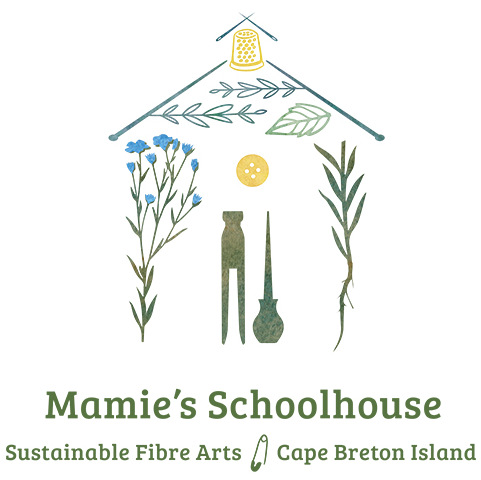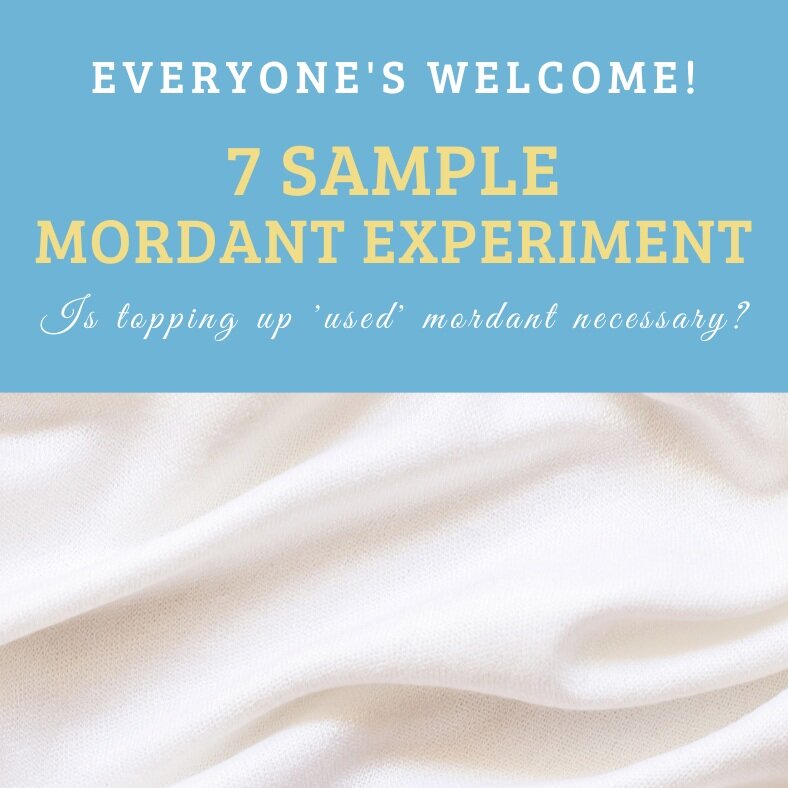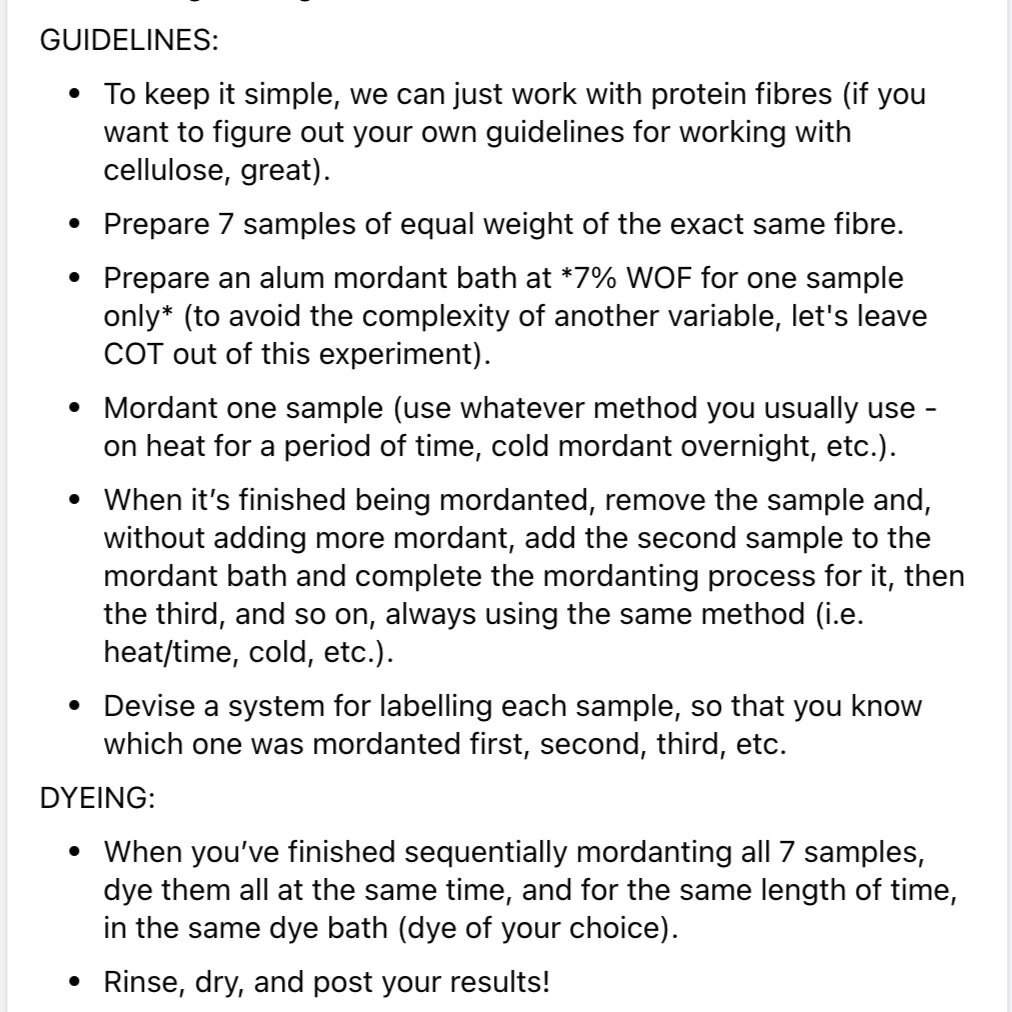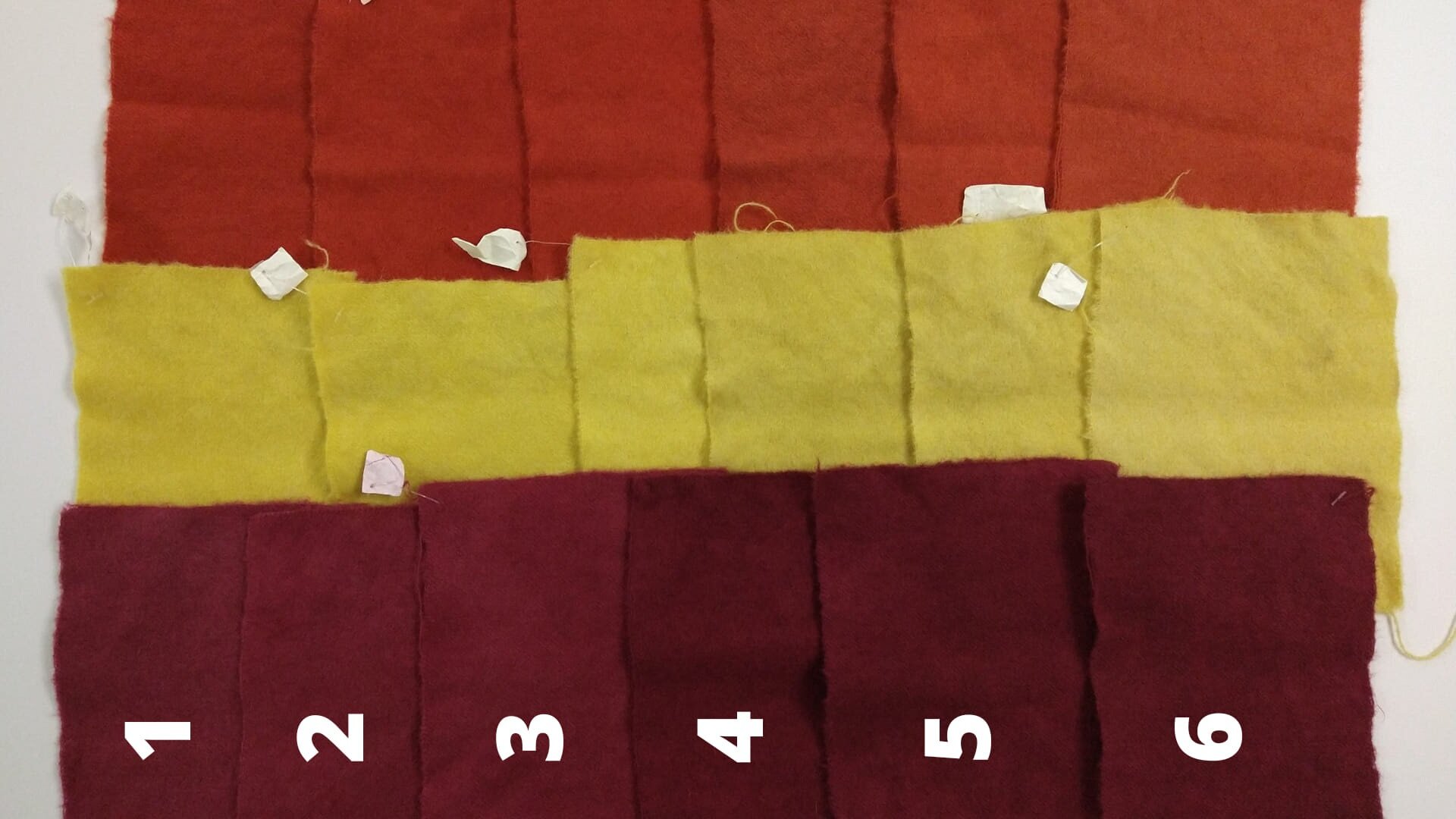Mordant Over-Use: Protein?
This is a collaborative blog post by members of the Natural Dye Education Facebook Group. See below for individual contributors.
Introduction:
The inaugural Natural Dyes in North-east America Conference took place online from late 2020 through Spring 2021. One of the presentations was by Professor Sherry Haar, Kansas State University, and detailed results of research quantifying the amount of mordant actually taken up by fibres. Her experimental methods measured the distribution of aluminum mordant ions across the pre-mordanding process for wool and cotton using inductively coupled plasma–mass spectrometry and the effluent quality characterized through chemical oxygen demand and total organic carbon. She found that with cotton, 92-96% of the aluminum remained in the effluent bath. With wool, the amount of mordant left in the bath ranged from 26-68% dependent upon particular fibre type and initial mordant concentration. The research also demonstrated something that seems paradoxical - that the lowest WOF of alum mordant used in some trials (7%) resulted in the most mordant being taken up by the fibres.
Research Study: How Much Mordant Is Being Disposed? The Measurement and Environmental Impact of Mordanting Natural Dyes.
Conventional Recommendations:
Many natural dye supply sellers advise very high mordant amounts (sometimes up to 15-20%), and also advise dyers to top up mordant baths for each subsequent use, without citing any evidence.
The usual advice for re-use of a mordant bath is to top up with 50% of the amount of mordant that you want for the next batch of fibres. So, for example…
1st use of mordant bath: you mordant 100gm of fibre using alum at , say, 8% (i.e. 8 gm)
For the 2nd use of the same mordant bath: for 100 gm of new fibres, you top up with 4% alum (i.e. 50% of the 8% alum you would use if you were creating a mordant bath from scratch)
and so on for each subsequent use of the same mordant bath
So, for 500 gm of fibre, you could end up using 24 gm of alum. But is this necessary?
Citizen Science:
Professor Haar’s research provides an opportunity for natural dyers to re-think optimal mordant amounts, the necessity of topping up mordant baths - at all - for re-use, as well as having significant implications for safe mordant bath disposal, given the amount shown to remain behind in the mordant bath after use.
To further test the relevance of these research findings for natural dyers, in February 2021, I launched a citizen science collaboration in the Natural Dye Education Facebook Group.
Our Approach:
To keep it simple, in the first instance we chose to work just with protein fibres, and to use dye uptake as a visual indicator of effective mordanting of each successive sample. As mordants form coordination complexes between themselves, the fibres and the dye, if less mordant is being taken up by each consecutive fibre sample mordanted in the same, un-topped-up bath, we would expect to see a progressive diminishment in colour in the dye results across the seven samples. The following guidelines were shared in the group.
Results:
Contributing dyers, alphabetical by surname. Where a dyer has provided more than one image, use the arrows to scroll through all images and their descriptions.
DOUG BEGGS
Dye Used: Weld / Reseda luteola
Notes:
Wool in top row; silk underneath. All samples scoured with heated water and 1% synthrapol, 1 hour, then cooled in pot, rinsed and dried some months ago. Sample set 1 wetted 1 hour then mordanted in 7% alum heated to 180 degrees F, held for one hour, then covered and cooled overnight in pot. Sample set 2 done in mordant exhaust from sample one, and so on with one set each day. Dyed in 100% WOF of combined 7 sets in chopped Weld. Weld bath prepared day before, brought to 160 degrees F, held one hour, then covered and cooled overnight. Next day dye bath strained then brought back to heat while all samples wetted in hot water. Then all 7 sets in the dye bath, brought to 160 degrees F, held for one hour then covered and cooled overnight. The wool samples are a jersey weave. Total pain as the samples curl up into a tube in the baths so very hard to get an even result.
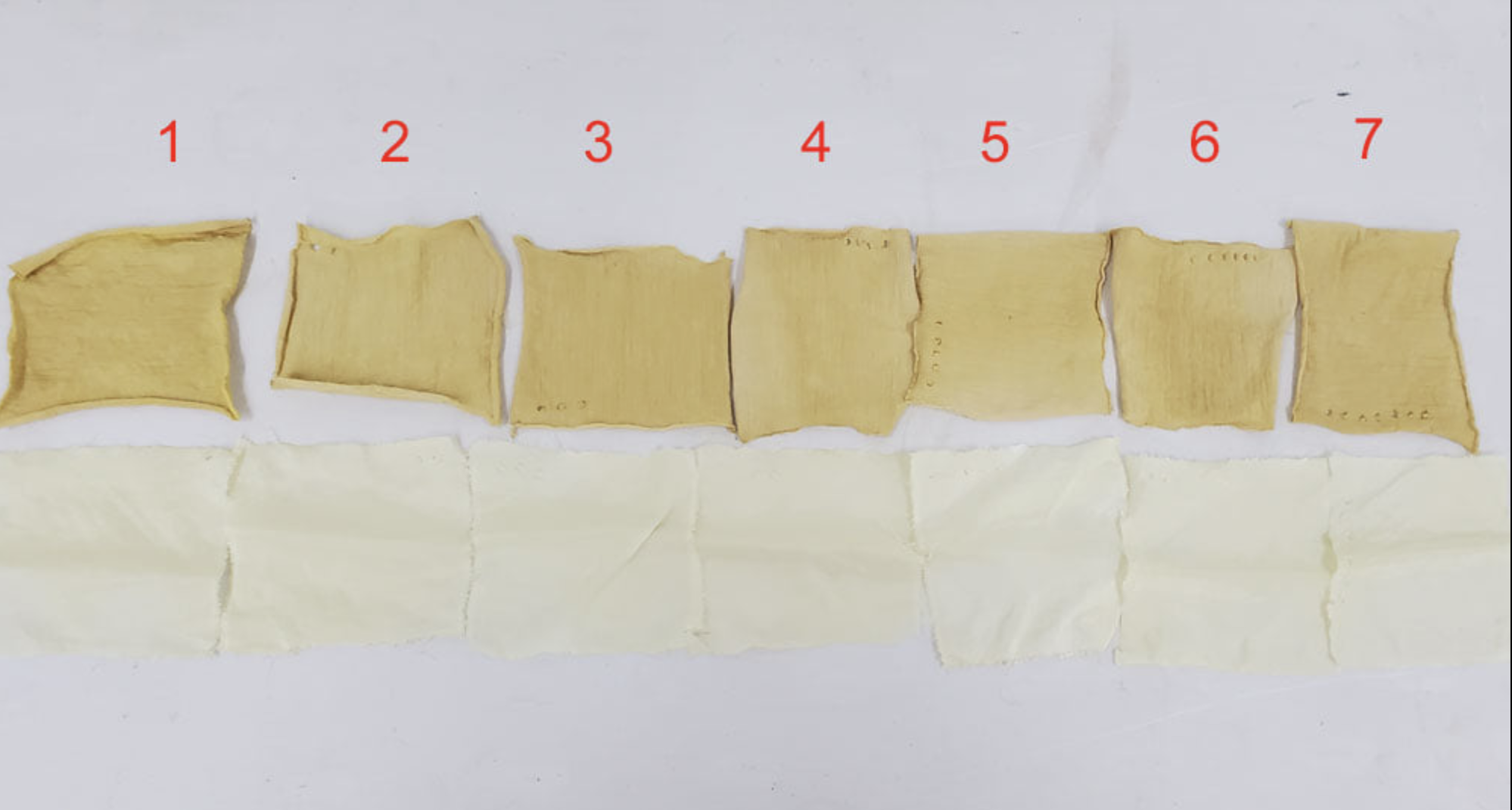
HEATHER BOGART
Dye Used: Madder / Rubia cordifolia
Links: Renaissance Canuck
Notes:
I decided to play with a brand new tub of madder (R. cordifolia) after a very long time working with very elderly container of madder. And hey.. there's an alum experiment going on. Well. My madder didn't care about alum. It didn't care about anything, I was pretty sure it was going to try and dye the cat next. 100g of madder got me almost a kilo of wool in pretty good colours (the last 300g of wool are lighter, but not even down to barely there!) So these 7 skeins (and bonus silk skein) were my alum experiment.
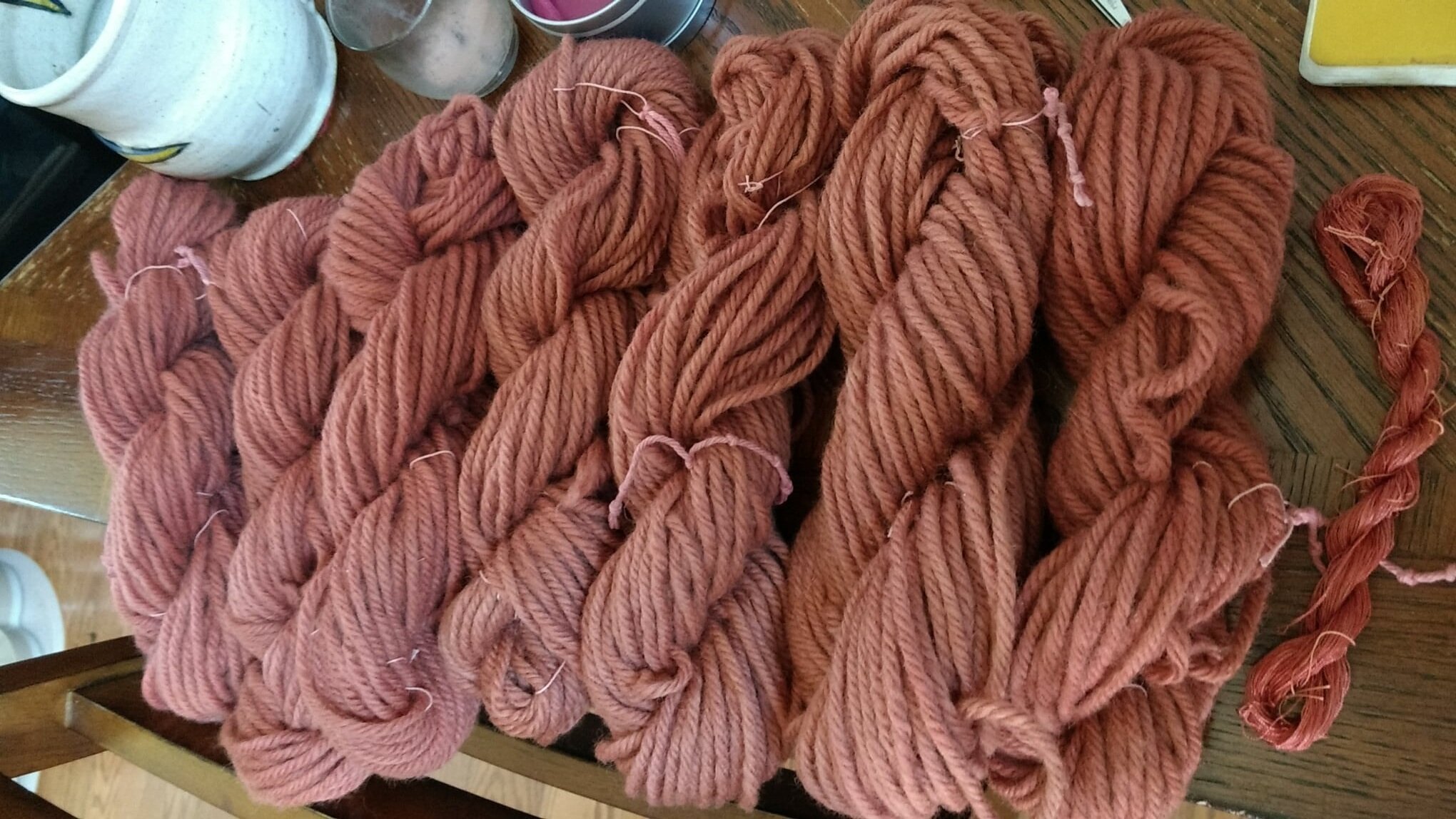
DONNA BUITENDYK FILLION
Dye Used: Lac / Kerria lacca
Links: Fair Colours
Notes:
I used wool blend yarn comprised of 80% merino, 15% cashmere and 5% nylon. Lac dye was used at 8% of total WOF (some recommend between 5-12% WOF). Samples #1 and #7 have the greatest differences with #1 being brighter than #7 which is on the way to brown. Interestingly, the actual experiment of available alum in each successive skein shows no appreciable difference after 7 uses. Does Lac have a huge affinity for wool so that the alum solution made little to no difference? To test this I should dye one without mordant as a control.
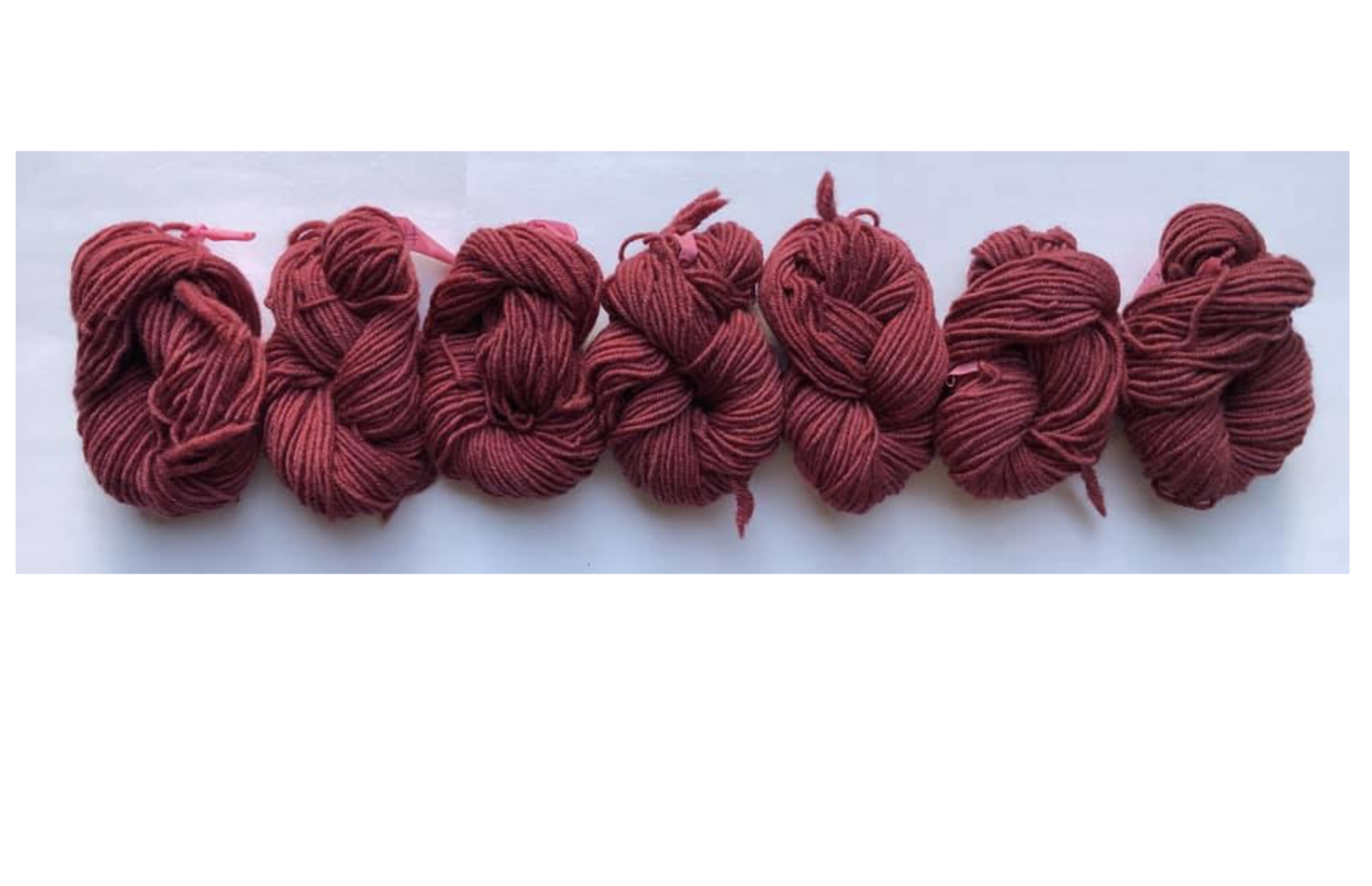
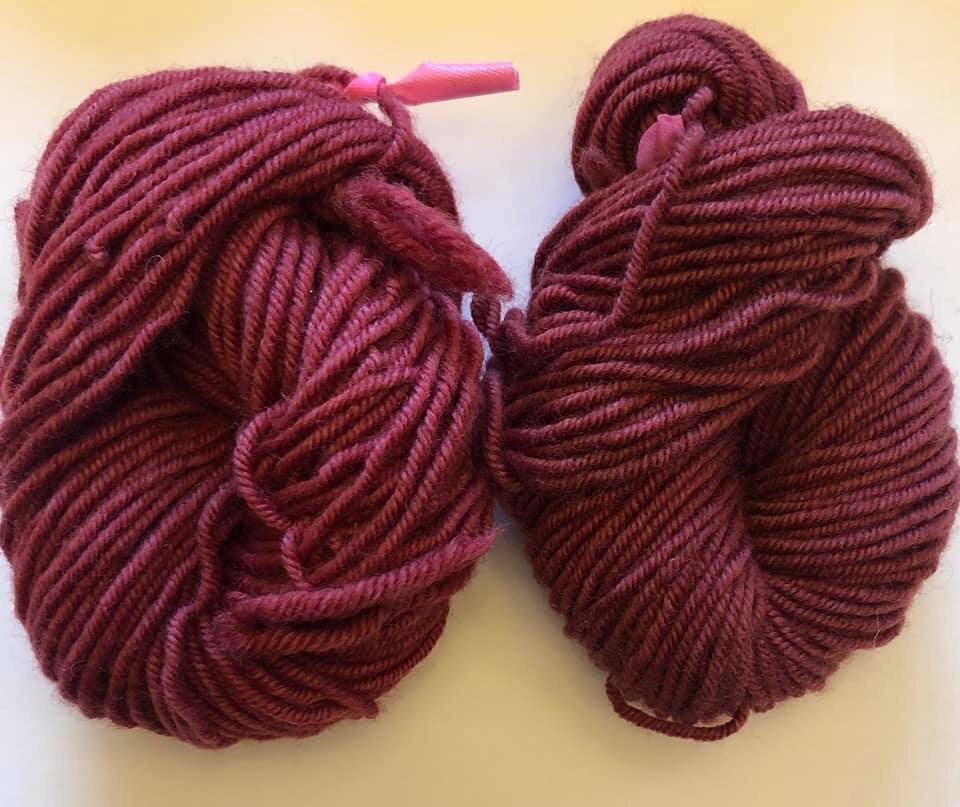
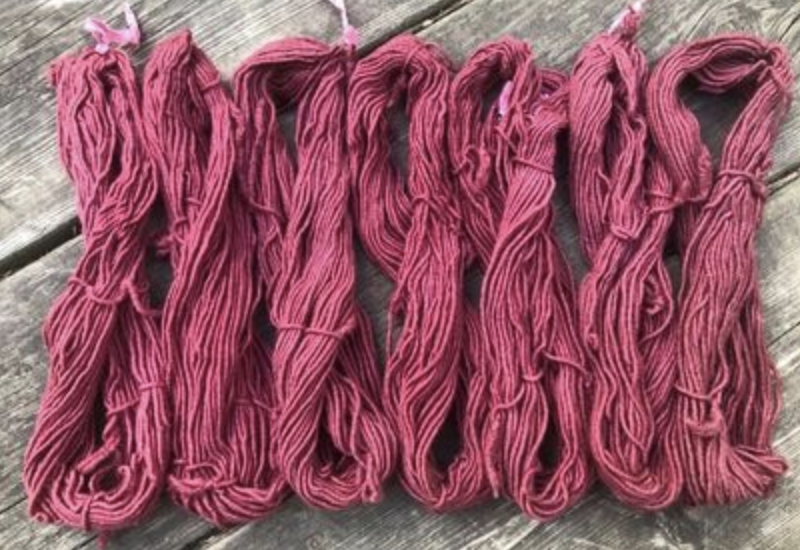
SUE CROOK
Dye Used: Dyer’s Chamomile / Anthemis tinctoria / Cota tinctoria
Notes:
After mordanting first sample no extra mordant added, second sample mordanted, continuing until each of the 7 has been mordanted. Dyed in anthemis tinctoria. Little difference between the colours.
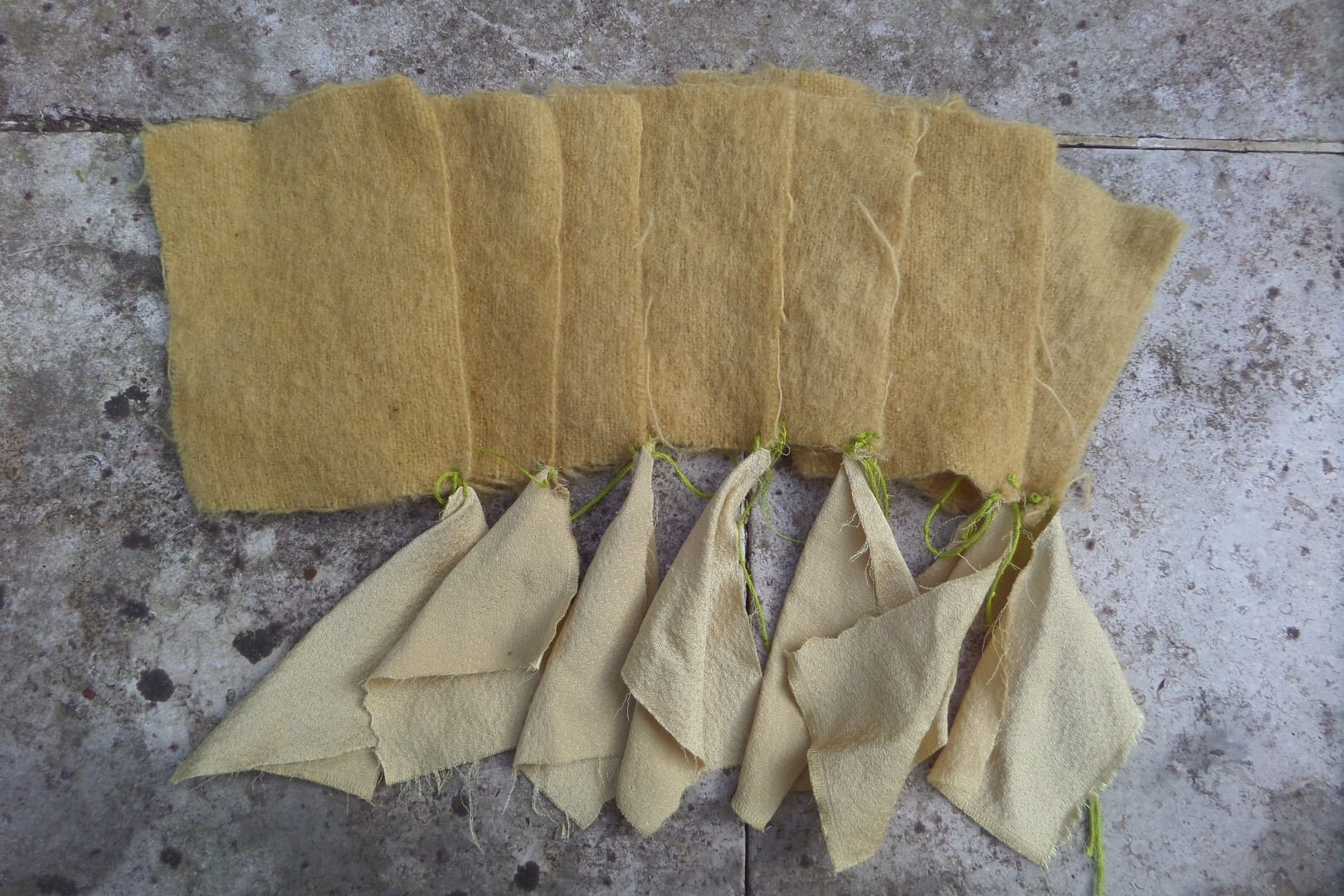
SUE GAZELL
Dye Used: Godenrod/Solidago
Notes:
I weighed out 8 skeins of natural white wool yarn at 14 grams each. They were soaked thoroughly in plain water. I made one mordant bath with 1 gram of potassium aluminum sulfate powder. Each skein was simmered successively in the mordant bath 1 hour, without adding any additional mordant, and numbered 1-8. These were hung to dry for more than a day, then soaked in plain water to thoroughly wet before immersing all 8 at once in a simmering dye bath of golden rod (solidago) for 45 minutes. They were hung to dry before washing. The first photo shows all 8 skeins, starting with 1, first one in the mordant bath, ending in 7. The 8th is laid out along the 7 others. There is no discernible colour difference. The 2nd photo is the first skein on the left, and 8th on the right. #1 has been kept indoors out of direct sunlight, while 2-8 have been outside in the sun for two weeks. Noticeable fading has occurred in 2-8, equally.
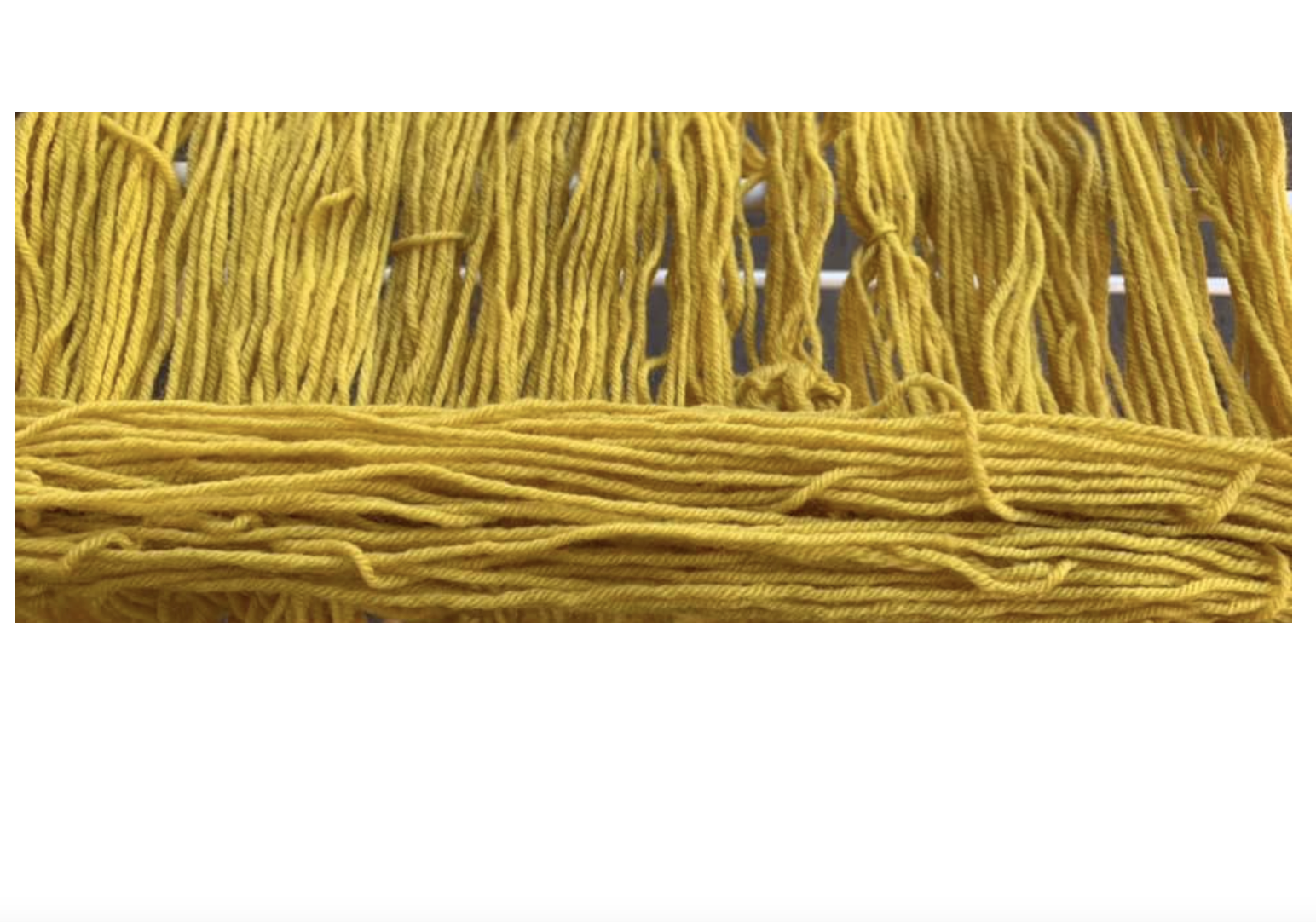

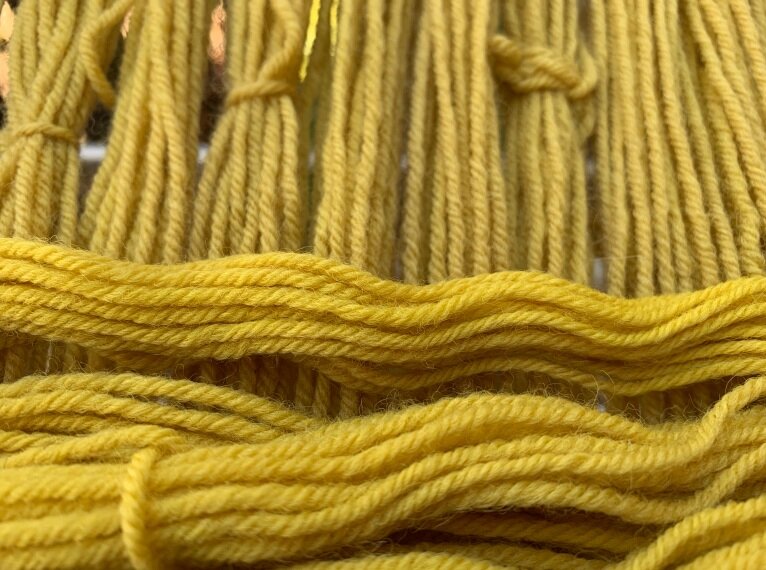
JEAN HALEY
Dye Used: Lac / Kerria lacca; Weld / Reseda luteola; Madder / Rubia cordifolia
Links: Dye & Design
Notes:
Mordant heated to ~180F then left overnight. I cut each numbered sample into 3 pieces so I could test 3 difference dyes. Bottom is lac @6%, middle is weld @50%, and top is madder (cordifolia) @50%. I used tap water, which tends to basic, though not not drastic. I live on top of the limestone capital of the world (southern Indiana, USA). Starting with #4 something is happening that may suggest that it's time to retire this enamel pot. I still don't see any chips in the pot, but especially looking at the weld, it looks like some iron has been introduced. In any event, there are not huge differences that I can see. Not big enough for me to consider adding any more alum to the pot before at least 6 uses. I will definitely be using a stainless steel pot, however.
J PALTANEN
Dye Used: Weld / Reseda luteola
Links: Blue Trillium Textiles / Instagram
Notes:
100% wof of last summer’s Weld and 7 skeins of 2/8 wool. The skeins were mordanted in 7% alum, successively, for 24 hours at room temperature, and then left to cure for at least a week. Weld was soaked in boiling water and left to cool overnight, and I added a tums (calcium) to brighten it. The skeins were added to the strained dye bath, gently simmered for 45 minutes, and left to cool for a total dye time of 24 hours. The first three skeins are nearly identical, and the last four are much lighter.
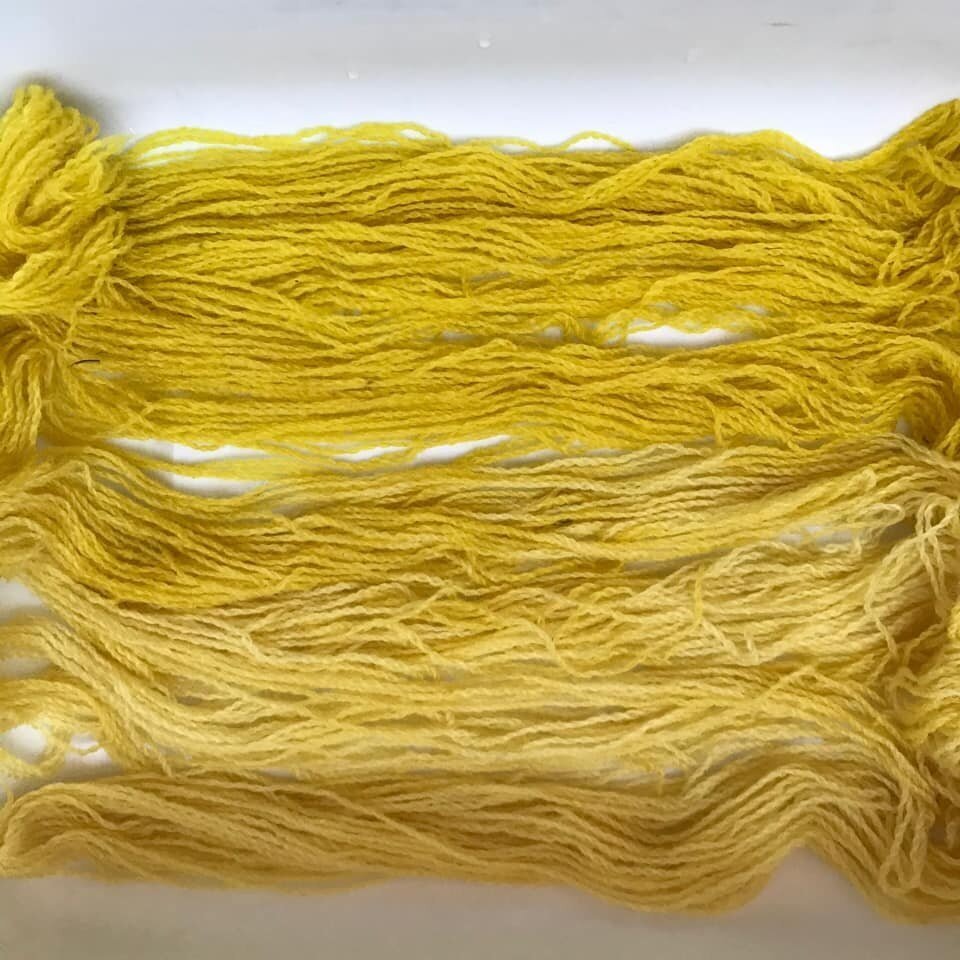
KIRSTY SUTHERLAND
Dye Used: Madder / Rubia tinctorum
Links: Botanical Prints and Natural Dyes: environmental art inspired by Granton’s lost medieval garden
Notes: (Kirsty used a somewhat modified method)
Three consecutive samples into 7% PAS with heat for one hour then rinse. One at end as control with no alum. Just tiny skeins from a 30g ball split in four. Previously dyed to a pale beige with dock seed dye in the summer of 2020 (unmordanted). Madder root dye used at ~50% wof. Bath pH 7. Notes were that alum did have an effect on dock seed dye colour before the madder bath. Slightly pink tone to sample 1 & 2 compared to 3 and no alum. Hardly noticeable on final samples excepting for slightly brighter terracotta orange colour. I definitely overheated my madder bath just at the end when I answered the phone. Reached a rolling boil…oops. Before that stage there did seem to be a bigger difference to the tones of red/orange in the skeins in the bath together. Once overheated everything became more brown orange.
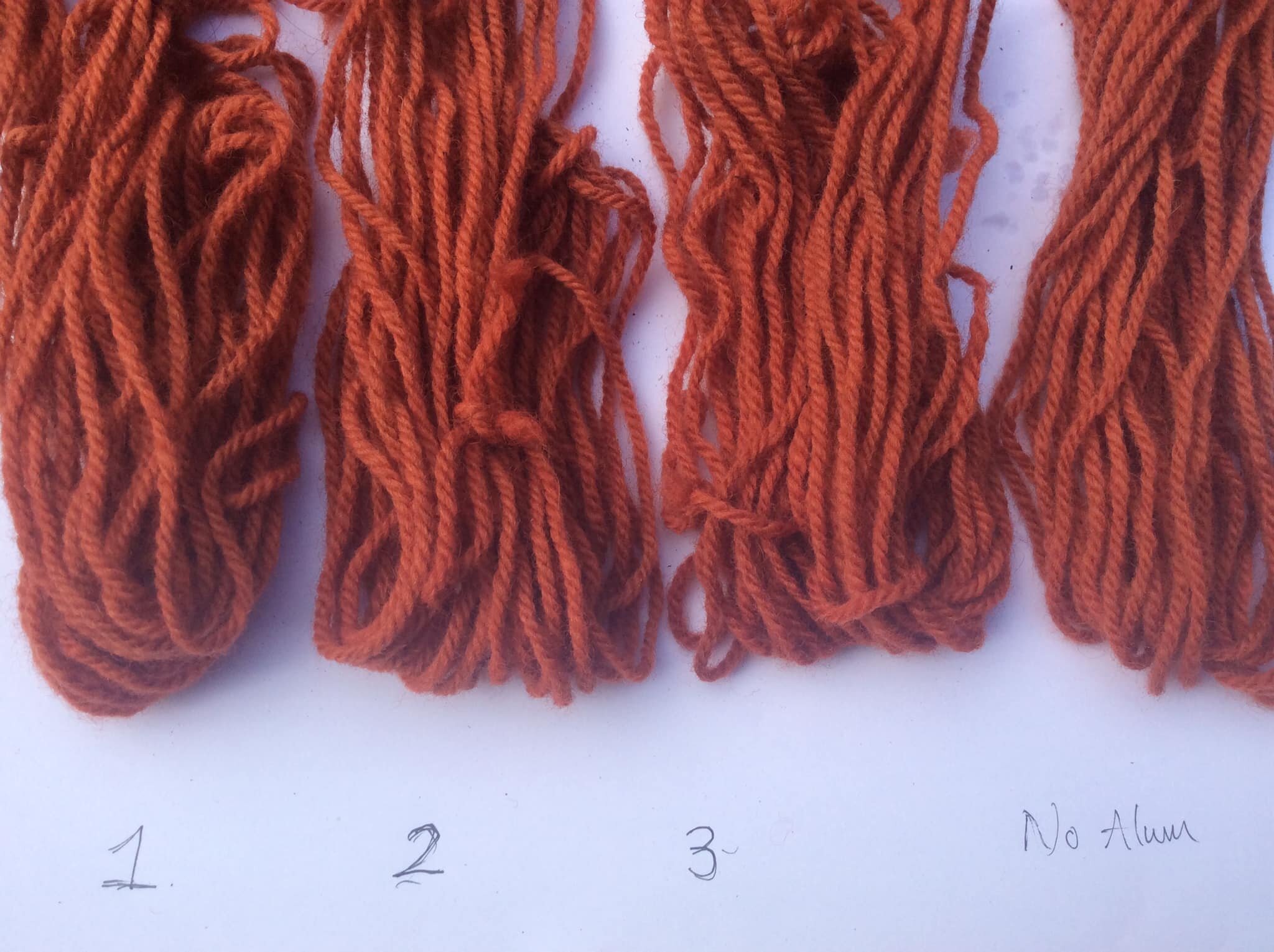
MEL SWEETNAM
Dye Used: Himalayan Rhubarb / Rheum emodi
Links: Mamie’s Schoolhouse Website / Instagram / Facebook / Admin, Natural Dye Education Facebook Group
Notes:
Scoured pure wool mini-skeins were consecutively cold mordanted overnight in the initial mordant bath. The mordant bath was well stirred prior to each subsequent use, to ensure any alum that had precipitated out was re-dissolved and evenly distributed in the mordant exhaust bath. The dye bath was made with 25% weight of fibre of powdered plant material, brought to below a simmer for one hour, fibres added for one hour, then taken off the heat and the fibres allowed to cool in the dye bath overnight before rinsing and drying. An un-mordanted mini-skein was also included in the dye bath for comparison. The un-mordanted sample clearly demonstrates - by contrast - the effect of the mordant in enabling much deeper colour, while the mordanted mini-skeins show no discernible colour difference between the first skein mordanted in the 7% alum bath and the last/7th skein mordanted in that same mordant bath.
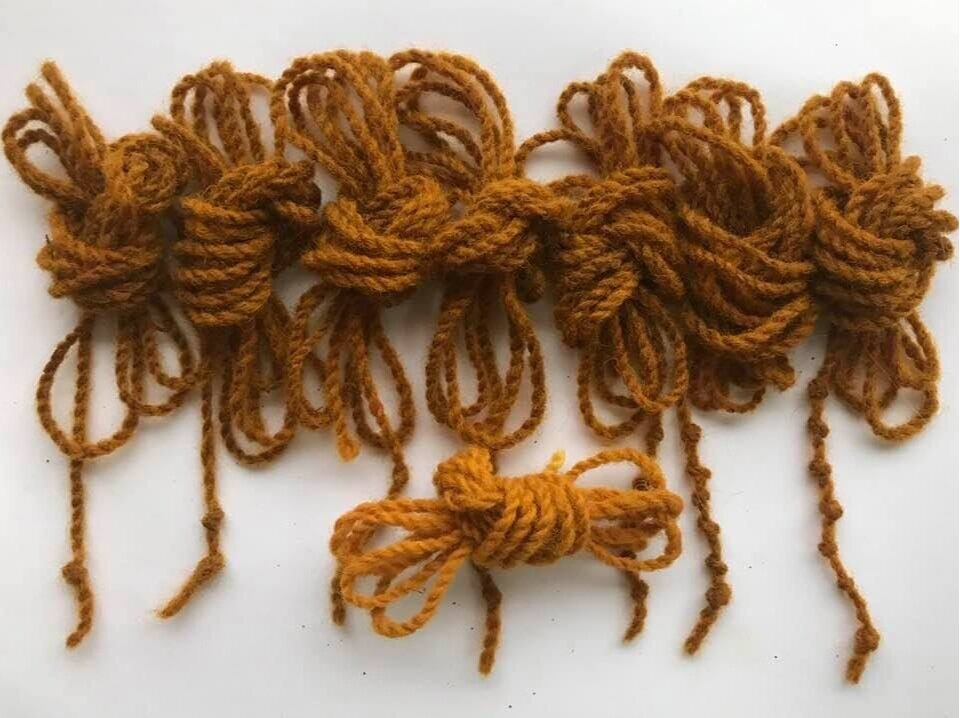
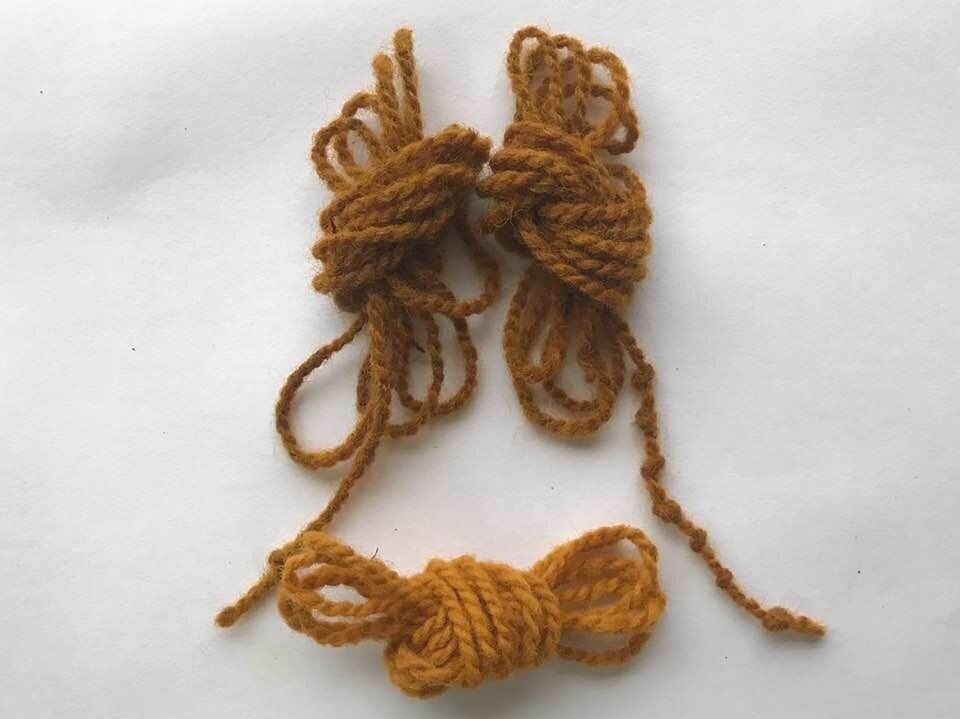
JOHN WALKER
Dye Used: Unidentified Eucalypt
Links: La de da Yarns
Notes:
I had 2 skeins on my bobbins and skeined them into 8 x 45m mini skeins. Yarn is a homespun blend of mostly Suri, and some Huacaya, Alpaca. I dyed with a fresh picked leaf Eucalypt, as it doesn’t need a mordant, but I used it as a colour modifier. From the right; 1st is dyed with no mordant. Then the mordant skeins begin, and slowly diminishing effects, along to the left. On left is a full, plain skein. Conclusion for me: the 1st 2 alum tests are the same. Then the 3rd skein is getting 'hungry looking'. The last 4 are the same as the skein with no mordant. In future I will be using Alum at 7% instead of 10%, and not topping up on a second turn. After that my results show there is a rapidly diminishing effect.
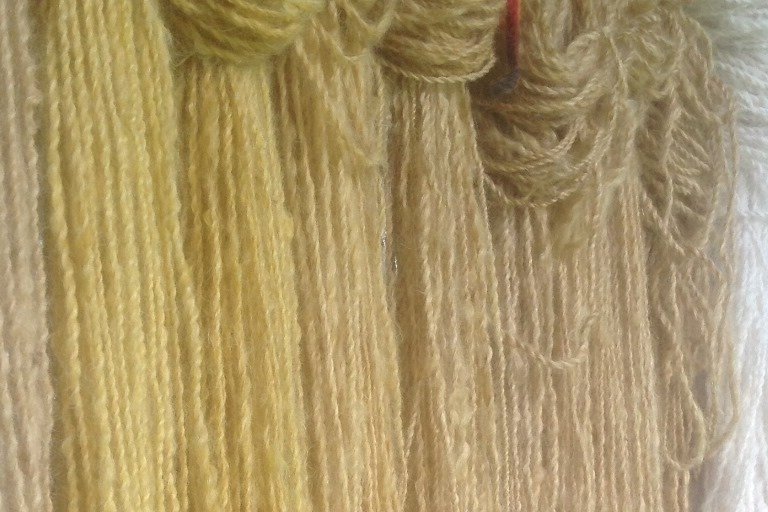
Further Thoughts:
There are most certainly particular natural dyes, and methods designed to achieve particular results, where a higher amount of mordant may be justified. The historic record is rich with such examples. However, this generally does not apply to much of the day to day practice of most natural dyers, who are looking for the most efficient use of resources to achieve a satisfactory colour result, and who are increasingly concerned with how to practice their craft in an ecologically responsible way.
We know that protein fibres have a high affinity for most natural dyes anyway, so the relative effect of each subsequent use of a mordant bath - without topping it up - may be easier to visually gauge using cellulose fibres, so that will be the next citizen science project in the Natural Dye Education Facebook Group.
Conclusions:
From these initial experiments, we can make some preliminary observations regarding how the following categories of dye compounds appear to respond to a mordant bath that is not topped up.
Anthraquinoid dominant dyes (Lac, Madder, Himalayan Rhubarb) show little/no diminishment in colour uptake after 7 uses of the same mordant bath. We know, however, that many anthraquinoid dominant dyes can be used without mordants on protein fibres, though mordants significantly intensify colour and improve dye fastness. We can see this in those tests where an un-mordanted sample was included for comparison - the mordanted samples took up more dye than the un-mordanted sample did, and the dye uptake appears to be consistent across the mordanted samples, with none of the diminishment of colour we would expect to see if consecutive samples were taking up less mordant.
Flavonoid dominant dyes (Weld, Goldenrod, Dyer’s Chamomile, Eucalypt) show more variable results. However, we can’t yet draw hard conclusions from the tests with flavonoid dominant dyes, due to the variability in dyers’ processes. For example, some dyers used calcium carbonate to harden and alkalinize their dye bath water (a time-honoured technique for facilitating the richest yellows), and others did not. Some used fresh dye baths, while others used exhaust dye baths, and so on.
The Dyer’s Chamomile and the Goldenrod tests show little/no discernible difference in colour from 1st through 7th samples.
One of the Weld tests showed little/no discernible difference in colour from 1st through 7th samples, whereas another Weld test showed a noticeable drop off in colour uptake in the 4th through 7th samples. There are any number of process variations that could explain this variability in result when using the same dye material.
The un-identified Eucalypt leaf test shows a noticeable drop off in colour uptake in the 3rd to 7th samples.
On balance, contributing dyers feel that the exercise has highlighted the general effectiveness of using alum with protein fibres at 7% weight of fibre, and that, for most dyes trialled, the mordant bath does not need to be topped up at least for the first few re-uses for certain flavonoid dominant dyes, and not at all for some other flavonoid dominant dyes or for anthraquinoid dominant dyes (up to 7 or 8 uses, anyway).
This information can provide for a much more cost-effective practice for natural dyers, as well as having a significant cumulative beneficial effect on reducing the amount of un-used mordant being discharged into soil and waterways.
Next Steps:
One of the cornerstones of credible test findings - in any field - is replicability of results. So we look forward to others trying this test - using the same guidelines above - to build a more robust set of samples to corroborate - or challenge - our initial findings.
This blog post will be updated if/when additional dyers contribute test results, including lightfast tests being conducted on samples by several of the dyers above.
As previously noted, a comparable citizen science collaboration will shortly be launched in the Natural Dye Education Facebook Group for cellulose mordanting.
With gratitude to all participants.
Acknowledgment:
This is original research designed and coordinated by Mel Sweetnam, Mamie’s Schoolhouse. A literature review was conducted (scientific research, historic references, contemporary web sites/blogs), and no prior references to reusing a mordant bath without topping up were found. Therefore, anyone referencing this approach should acknowledge Mel Sweetnam, of Mamie’s Schoolhouse, as the originator .
Cite as follows.
Sweetnam, Mel. “Mordant Over-Use: Protein?” Natural Dye Blog, April 5, 2021, https://www.mamiesschoolhouse.com/blogarchive/2021/3/30/mordant-over-use
We welcome your comments below.
